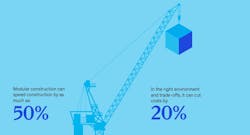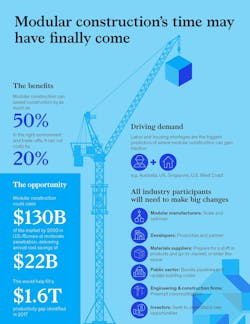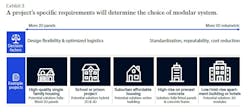Modular construction can deliver projects 50% faster
Modular construction can deliver projects 20% to 50% faster than traditional methods and drastically reshape how buildings are delivered, according to a new report from McKinsey & Co.
Modular carries a potential cost savings of up to 20%, but there is a risk of up to a 10% loss if delivery or material costs spike, the report says. The global market is primed for the sweeping change that factory-built construction offers.
To realize all of modular’s benefits, the building team must choose the right design and right materials as well as overcome challenges in design, manufacturing, technology, logistics and assembly; and take advantage of locations where they can achieve scale and repetition. Public sector owners and regulatory agencies are well positioned to drive the industry toward modular.
Up to now, prefab home building has achieved a sustainable foothold in only a few places, including Japan and Scandinavia, the report adds. That may change as labor shortages become more acute and the industry adopts new, lighter-weight materials and digital technologies that enhance design capabilities and variability, improve precision and productivity in manufacturing, and facilitate logistics for the construction of prefab homes.



